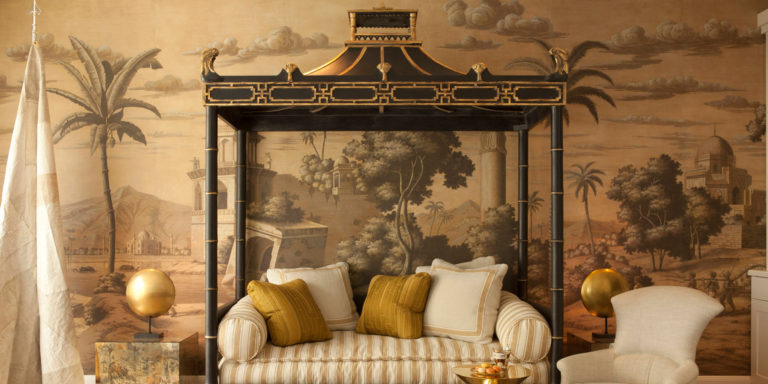Since its founding in 1984, the Chinese Porcelain Company has been a favorite New York City destination for cognoscenti of all stripes: international collectors, society mavens, museum curators and plain-old culture-vultures. Occupying an elegant corner of Park Avenue and 58th Street, it’s a beautifully decorated showcase for, as its name suggests, Asian ceramics, but also 18th-century French and Italian antiques, artworks and sculpture, as well as contemporary Chinese paintings.
It is a discreet space for discreet people, but not at all stuffy, thanks in part to the diversity of its wares. Here, otherworldly Chinese ink landscape paintings by the contemporary Beijing master Liu Dan and gigantic paintings by his student Tai Xiangzhou hang above 18th-century French commodes, on top of which sit Tang Dynasty horses, Chinese export porcelain and contemporary hand-sculpted and -painted botanical sculptures by the Bordeaux-based American artist Carmen Almon.

Above: The storefront of the Chinese Porcelain Company reveals its varied treasures. Left: The gallery’s example of an exceptional 18th-century Tric-Trac table, possibly fashioned by the maître Adam Weisweiler. Top, the tric-trac board. All photos by Josh Gaddy

English-born Conor Mahony was vice president of the Chinese department at Sotheby’s in New York before assuming the role of president at the Chinese Porcelain Company in 1994.
Amid all this delectable variety, one recent acquisition in particular stands out: a Louis XVI games table made in France during the late 18th century. Measuring 45 inches across, which is slightly wider than normal for this type of piece, the rectangular mahogany table has fluted legs on bronze castors and gilt bronze mounts. Two drawers fitted with locks hold antique chess pieces, dice and counters. At first, because its top is inset with a green-leather surface, the table appears to be a fine neoclassical writing desk. But turn over the leather top and you’ll discover a green-baize expanse perfect for card playing. Beneath that is a shallow well designed for backgammon, complete with 12 holes for scoring pegs, known as fiches, and openings at either end for (now missing) silver candle holders. And beneath the backgammon? A slide-out board for checkers or chess.
“Gaming was a favorite pastime in eighteenth-century France,” says Conor Mahony, the gallery’s president. “Of the many games played, tric-trac, a form of backgammon, was one of the most popular.” (The word “tric-trac” is said to mimic the clicking of dice.) Originally, the game was played on a portable board, but starting in the early 18th century, the French created multipurpose writing and card tables that, when their tops were removed, revealed tric-trac, chess and checkers surfaces beneath.
One can easily imagine Marie Antoinette, surrounded by her ladies in waiting, playing at such a table with an elegant Swedish count. The table has its original casters and would have been — and still can be — pulled into the middle of the room for games.
Today, the Chinese Porcelain Company has priced the table at $75,000. Here, Mahony explains why.

The inventory of the gallery — which regularly publishes scholarly catalogs and stages special exhibitions — proves more varied than its name suggests.

The piece is a composite of finely wrought details, including, clockwise from top left, sliding lockable drawers, bronze castors, a backgammon surface made from ebony and a green-baize surface for card playing.
QUALITY OF DESIGN
The classical design is pure Louis XVI, complete with fluted legs. “It looks like a piece by Adam Weisweiler, and it would cost one-hundred-and-fifty-thousand dollars if it had been signed by him,” says Mahony, referring to the masterful German furniture-maker who settled in Paris in the 1770s and produced commissioned furniture for Marie Antoinette (and later the Bonapartes). Weisweiler’s work is known for its elegant clean lines, delicate mounts and perfect craftsmanship. (And high prices: On July 10 in London, Christie’s sold a pair of Weisweiler ormolu-mounted, Japanese lacquer and pewter-inlaid ebony console tables for $1,032,083.) There are Weisweiler antiques in such prominent collections as the Getty, the Philadelphia Museum of Art and the British Royal Collection.
The materials comprising the table are first-rate. The highly figured mahogany, probably from the West Indies, was imported to France, where it would have been prized (and expensive). The inlays are equally exotic: pale fruitwood and ebony. The workmanship is impeccable. “Even though the table isn’t signed, it was obviously made by someone who was very, very good,” Mahony says. “They gave their best materials to their best craftsmen.”
Ulrich Leben, a research scholar at the Bard Graduate Center in New York, adds: “The fact that it’s not signed doesn’t mean anything special. The table could have been made for a noble or a bourgeois, as these pieces were very fashionable and could easily be obtained by a marchand-mercier who shopped in the Faubourg Saint-Antoine, where there was no obligation to stamp pieces.”

As Mahony points out, antique tric-trac tables themselves aren’t particularly rare. Rather, it’s the quality, workmanship and condition of the materials of this particular piece that determine its value.

Among its other accoutrements, the table comes with antique chess pieces.
RARITY
Tric-trac tables are not rare, but fine ones are. “You can buy one for $2,000 or $100,000,” Mahony says. “It’s all about quality. Whenever I look at this one, I get such a good feeling I don’t care if I sell it. It’s bigger, bolder and of better quality than anything out there.”
The Chinese Porcelain Company has a sterling reputation for selling top quality, rare French pieces, mostly to private collectors in the U.S., Europe and South America. In the past few years, it has sold a 1765 Louis XV giltwood fauteuil à la reine attributed to Nicolas Heurtaut of Paris to the New Orleans Museum of Art; a set of six fine Louis XVI mahogany side chairs by Georges Jacob, ca. 1785; and a spectacular Louis XVI mahogany “table à la tronchin” (a table with a tilt-up top for reading books or music), ca. 1780, by Pierre Garnier. So when Mahony says something “is of better quality than anything out there,” he knows whereof he speaks.
PROVENANCE
It is not known for whom the table was made, but Pierre Durand, owner of the gallery, acquired it privately from a noble family in Paris. “He bought it through a contact,” Mahony says. That means it has not been on the market, which makes it “fresh” to potential collectors.
“Its appeal is that it’s best-in-class,” Mahony says in conclusion. “It’s so many things in one: It is a really good writing desk but also a wonderful card table and a place to pay checkers, chess and backgammon.”
Rare, finely made and multipurpose? A worthwhile acquisition indeed.



